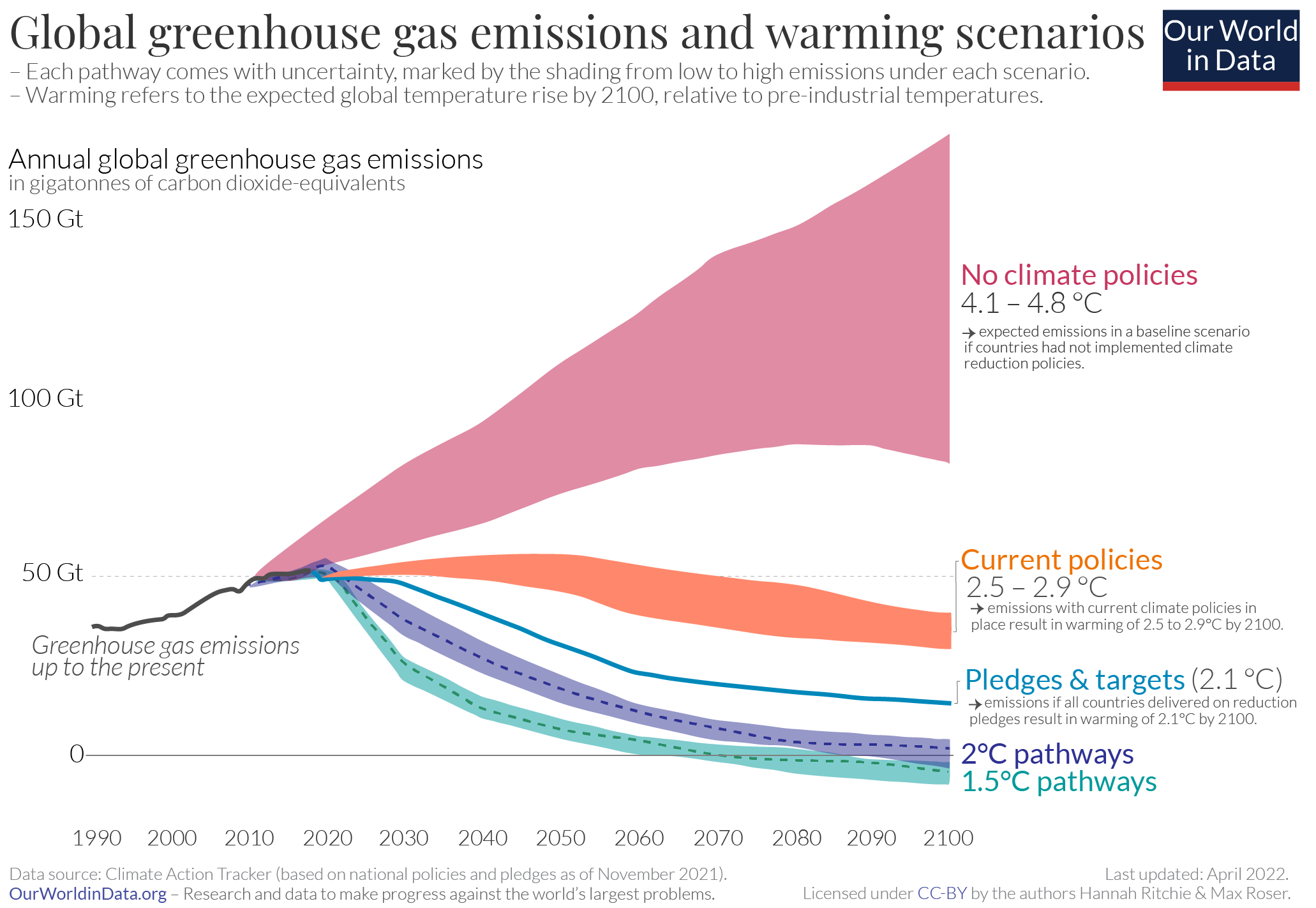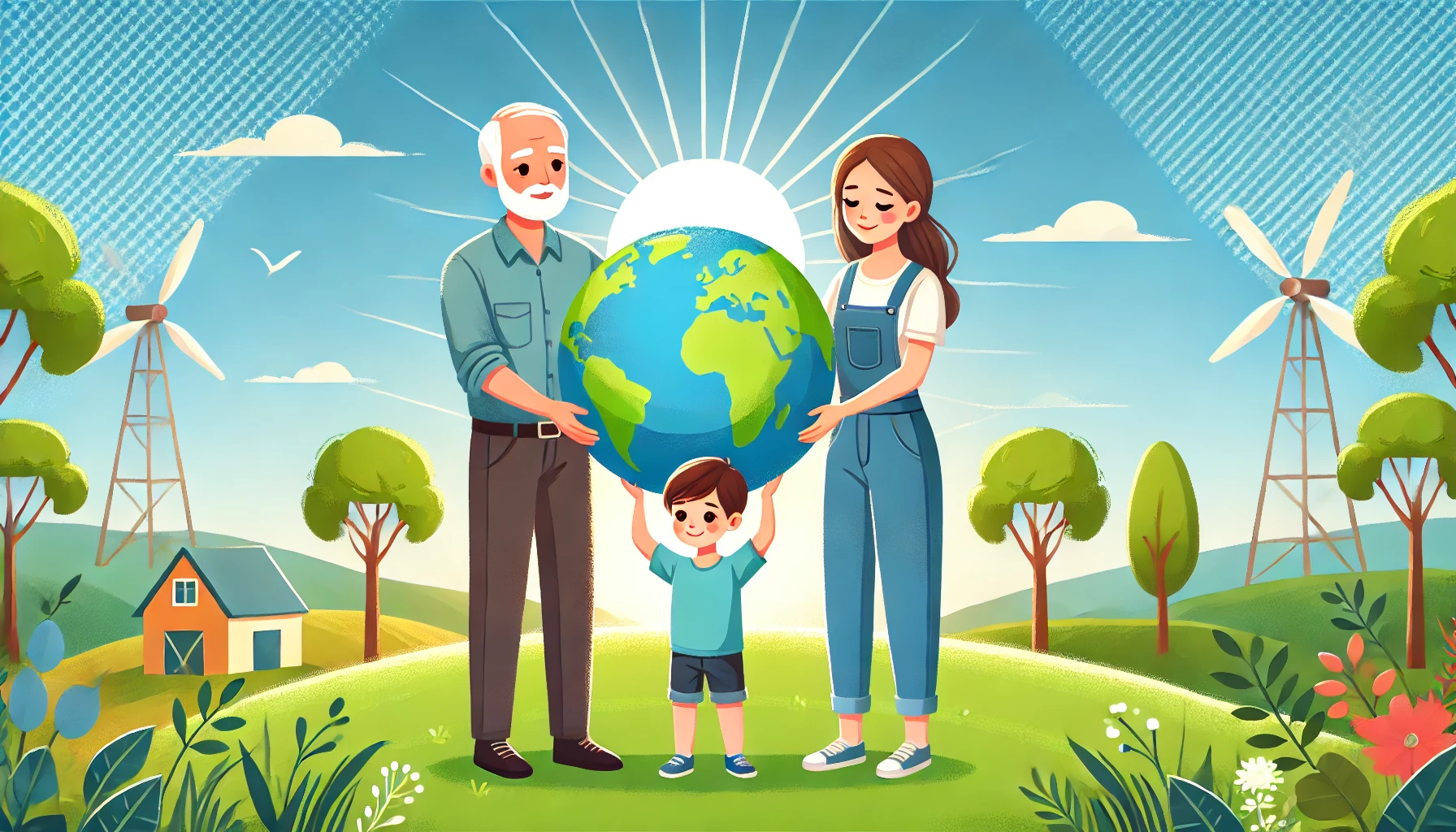By Kristi Sturtz, ALM, AICP
Read: Climate Change Series – Part 1
The Potential Consequences of Climate Change: A View Through Time
Climate change is a pressing issue that has the potential to reshape the world as we know it. The consequences are vast and varied. To help understand the situation, it is important to look at global temperatures throughout history and consider what lies ahead for our families.
Global Temperatures Throughout History
Throughout Earth’s history, global temperatures have warmed and cooled in roughly 100,000 year cycles due to natural factors like volcanic activity, changes in the Earth’s orbit, and the angle of how sunlight hits the earth; during the height of the last Ice Age, approximately 20,000 years ago, global temperatures were about 3 to 8 degrees Celsius (5 to 15 degrees Fahrenheit) cooler than the present.1 After this last Ice Age (circa 10,000 BCE), average temperatures began to rise, leading to more favorable conditions for the development of agriculture and human civilizations.2
Livable Temperatures and Small Changes
A “livable” temperature varies depending on the region and local climate. A typical temperature range of 15 to 30 degrees Celsius (59 to 86 degrees Fahrenheit) is considered comfortable and conducive to agriculture and daily life.3 Even small changes in global temperatures can have significant impacts on livability. A change of just 1-2 degrees Celsius can lead to the following:
~ Increased frequency and severity of heatwaves, affecting human health and mortality,
~ Altered precipitation patterns, leading to droughts in some areas and flooding in others,
~ Shifts in agricultural zones, impacting food security,
~ Melting of polar ice caps and glaciers, contributing to sea-level rise and threatening coastal communities.
Temperature Changes: Past and Present
Over the last 10,000 years, the Earth’s climate has been stable. However, the past one hundred years have seen unprecedented temperature increases due to human activities, particularly the burning of fossil fuels and deforestation. Since the late 19th century, the global average temperature has risen by approximately 1.1 degree Celsius (1.9 degrees Fahrenheit), with most of this warming occurring in the last few decades.4
Projected Temperature Increases
As shown in Figure 1, different global greenhouse gas and warming pathway scenarios are given leading to the year 2100. Children born today will likely be in their 70’s during that time. If climate reduction policies are absent, the global average temperature is expected to rise by 4.1 to 4.8 degrees Celsius (7.1 – 8.3 degrees Fahrenheit).
With current policies, projected warming by the end of this century is in the 2.5 to 2.9 degrees Celsius (4.3 to 5.0 degrees Fahrenheit) range. To further mitigate these risks, the international community has set a goal to limit global warming to 1.5 to 2 degrees Celsius above pre-industrial levels. Achieving this requires significant reductions in greenhouse gas emissions and a shift towards renewable energy sources.
Figure 15

Potential Consequences of Inaction
Failing to address climate change could lead to:
~ Widespread displacement of populations due to sea-level rise and extreme weather,
~ Increased frequency of natural disasters, straining emergency response systems,
~ Economic losses from damage to infrastructure, decreased agricultural yields, and health-related costs,
~ Significant sea-level rise leading to the displacement of people and businesses,
~ Heightened geopolitical tensions over resources and climate-induced migration,
~ More frequent and severe weather events (hurricanes, floods, droughts),
~ Loss of biodiversity as many species cannot adapt quickly enough to the changing climate,
~ Increased stress on water resources, leading to conflicts over water availability.
Consensus About Addressing Climate Change
Although debate over the reality of climate change still exists in some areas, the importance of addressing climate change is widely recognized:
Scientific Consensus: Over 97% of climate scientists agree that climate change is real and primarily caused by human activities.6
Global Agreement: The Paris Agreement, adopted by 196 countries, aims to limit global warming to well below 2 degrees Celsius, with efforts to limit the increase to 1.5 degrees Celsius.7
People’s Climate Vote 2024 Survey:8 The largest standalone survey of global public opinion found that over half of people globally are more worried about climate change this year than they were last year and four out of five want to see a strengthened commitment from their countries to address the issue.
Conclusion
The potential consequences of climate change are far-reaching and pose a significant threat to the future of our planet, our children, and our children’s children. By understanding the historical context of global temperatures and the projected impacts of current trends, it becomes clear that immediate and sustained action is necessary. Limiting global warming to 1.5 to 2 degrees Celsius is crucial to ensuring a livable world for future generations. The scientific community, countries and people worldwide recognize the urgency of this issue, and it is up to all of us to take meaningful steps towards a sustainable future.
Read Climate Change Series – Part 3
- Herring, D., Lindsey, S. (2020). Hasn’t Earth Warmed and Cooled Naturally Throughout History? Climate.gov U.S. Department of Commerce, National Oceanic and Atmospheric Administration. Hasn’t Earth warmed and cooled naturally throughout history? | NOAA Climate.gov ↩︎
- Encyclopedia Britannica. (2024) Holocene Epoch summary. Holocene Epoch summary | Britannica ↩︎
- McKenzie, R. (2017). Understanding the Effects of Sunlight, Temperature and Precipitation. Top Crop Manager. https://www.topcropmanager.com/back-to-basics-20879/ ↩︎
- IPCC, 2023: Summary for Policymakers. In: Climate Change 2023: Synthesis Report. Contribution of Working Groups I, II and III to the Sixth Assessment Report of the Intergovernmental Panel on Climate Change [Core Writing Team, H. Lee, and J. Romero (eds.)]. IPCC, Geneva, Switzerland, pp. 1-34,
doi: 10.59327/IPCC/AR6-9789291691647.001 ↩︎ - Ritchie, H., Roser, M. (2022). Global greenhouse gas emissions and warming scenarios. Our World in Data. https://assets.ourworldindata.org/uploads/2018/04/Greenhouse-gas-emission-scenarios-01.png ↩︎
- “Quantifying the consensus on anthropogenic global warming in the scientific literature,” J. Cook et al., Environ. Res. Lett., 8 024024, doi:10.1088/1748-9326/8/2/024024 (2013). ↩︎
- United Nations. (n.d.). The Paris Agreement. https://unfccc.int/process-and-meetings/the-paris-agreement ↩︎
- United Nations Development Programme. (2024). The World’s Largest Survey on Climate Change is Out: Here’s What the Results Show. https://climatepromise.undp.org/news-and-stories/worlds-largest-survey-climate-change-out-heres-what-results-show
↩︎


